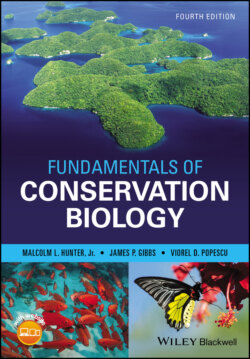Читать книгу Fundamentals of Conservation Biology - Malcolm L. Hunter Jr. - Страница 34
CASE STUDY 2.1 Clear Lake
ОглавлениеIn northwestern California lies Clear Lake, a large body of water (17,760 ha) that is shallow, warm, and productive; thus it supports a great abundance of fish. Originally, Clear Lake was home to 14 native kinds of fish, at least three of which were endemic to the lake: the Clear Lake splittail, Clear Lake hitch, and Clear Lake tule perch (Moyle 1976a ; Thompson et al. 2013) (Fig. 2.4). However, beginning in the late 1800s and continuing through the 1980s, people tried to increase the fish diversity of the lake by importing exotic species, primarily sport fish sought by anglers. Stocking began with carp and two species of catfishes and continued at irregular intervals, primarily with members of the Centrarchidae family (sunfishes and basses) native to the eastern United States. One species introduced in 1967, the Mississippi silversides, soon became the most abundant species in the lake. In the face of this competition and some other issues, all of the native species have declined dramatically, and only six native species may remain common in the lake. Worse still, two of the native species that have disappeared from the lake (the Clear Lake splittail and the thicktail chub) are globally extinct. The net scorecard: misguided attempts to enrich the fish fauna of Clear Lake increased the number of fish species there from 14 to 30 by adding 26 exotic species, but these introductions have decimated the lake’s native fish fauna, eliminating two elements of biodiversity from the entire planet and reducing gamma diversity. Most conservation biologists would argue that this was not a good trade. Recently some conservation biologists have disagreed about the relative importance of alpha versus gamma diversity (or, as more generally expressed, local versus global species richness), primarily because they believe that ecosystem function is more important than the nativeness of the biota (Primack et al. 2018).
Figure 2.4 Clear Lake in northern California used to be inhabited by 14 native species of fish until fisheries managers began introducing new fish species, 26 in all. These introductions decimated the native fish populations, but still produced a net increase in alpha diversity of 16 species. This increase came at the expense of gamma diversity at a global scale because two of the original species, the Clear Lake splittail and the thicktail chub, are now globally extinct.
